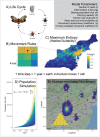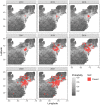Human-mediated dispersal drives the spread of the spotted lanternfly (Lycorma delicatula)
- PMID: 36658159
- PMCID: PMC9852583
- DOI: 10.1038/s41598-022-25989-3
Human-mediated dispersal drives the spread of the spotted lanternfly (Lycorma delicatula)
Abstract
The spotted lanternfly (Lycorma delicatula) is a novel invasive insect from Asia now established and spreading throughout the United States. This species is of particular concern given its ability to decimate important crops such as grapes, fruit trees, as well as native hardwood trees. Since its initial detection in Berks County, Pennsylvania in 2014, spotted lanternfly infestations have been detected in 130 counties (87 under quarantine) within Connecticut, Delaware, Indiana, Maryland, New Jersey, New York, Ohio, Virginia, and West Virginia. Compounding this invasion is the associated proliferation and widespread distribution of the spotted lanternfly's preferred host plant, the tree-of-heaven (Ailanthus altissima). While alternate host plant species have been observed, the tree-of-heaven which thrives in disturbed and human-dominated areas (e.g., along roads and railways) is likely facilitating the population growth rates of spotted lanternfly. We simulated the population and spread dynamics of the spotted lanternfly throughout the mid-Atlantic USA to help determine areas of risk and inform continued monitoring and control efforts. We tested the prediction that spotted lanternfly spread is driven by human-mediated dispersal using agent-based models that incorporated information on its life-history traits, habitat suitability, and movement and natural dispersal behavior. Overwhelmingly, our results suggest that human-mediated dispersal (e.g., cars, trucks, and trains) is driving the observed spread dynamics and distribution of the spotted lanternfly throughout the eastern USA. Our findings should encourage future surveys to focus on human-mediated dispersal of egg masses and adult spotted lanternflies (e.g., attachment to car or transported substrates) to better monitor and control this economically and ecologically important invasive species.
© 2023. The Author(s).
Conflict of interest statement
The authors declare no competing interests.
Figures







References
-
- Simberloff D, Keller RP, Cadotte MW, Sandiford G, editors. Invasive Species in a Globalized World. University of Chicago Press; 2015.
-
- Hall CM. Handbook of Globalisation and Tourism. Edward Elgar Publishing; 2019. Biological invasion, biosecurity, tourism, and globalisation.
-
- Simberloff D. How common are invasion-induced ecosystem impacts? Biol. Invasions. 2011;13:1255–1268. doi: 10.1007/s10530-011-9956-3. - DOI
MeSH terms
Supplementary concepts
LinkOut - more resources
Full Text Sources
Research Materials

